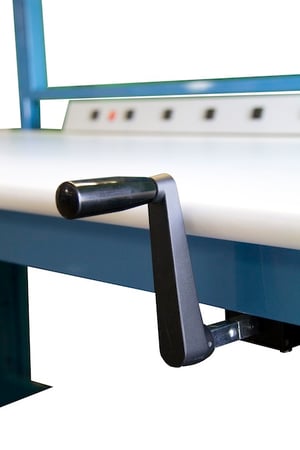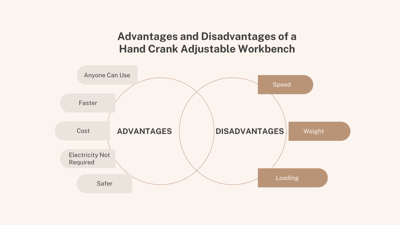Designing your lab to include adjustable workbenches is a smart way to prioritize efficiency while ensuring worker safety.
An adjustable workbench allows the user to adjust the height of the workstation based on their personal comfort level. The ergonomically-friendly design is important in today’s work environment considering that several studies have linked workbench height to musculoskeletal disorders (MSD).
In fact, the Centers for Disease Control (CDC) reports that MSD cases cost companies more than the average nonfatal injury or illness. MSD injuries are also associated with high costs to businesses, from increased worker’s compensation claims to lost productivity.
On the other hand, ergonomically-friendly industrial furniture is linked to better employee health, enhanced productivity, and improved employee retention and recruiting.
If you’ve been researching adjustable workbenches, you’ve likely come across one that is designed with a hand crank, which allows the user to manually lift and lower the workbench. While this is a popular design, it’s important to consider whether this type of adjustable bench is right for your lab.
Below we’ll dive into how a hand crank adjustable height workbench works, its advantages and disadvantages, and whether there are other options available to meet your lab’s needs.
How A Hand Crank Adjustable Height Workbench Works
Adjustable workbenches essentially shorten or elongate the legs of the bench so that an employee can sit or stand at a supportive level. A hand crank workbench is manual in design, meaning the user must do the work to lift it or lower it.
supportive level. A hand crank workbench is manual in design, meaning the user must do the work to lift it or lower it.
The hand crank makes it easier for the user to accomplish this, versus other methods such as a slot adjustment bench. (With a slot adjustment bench, a worker must make adjustments by raising the work bench legs and removing bolts or spacers.)
While a crank adjustable height workbench is still manual, the design makes it much more convenient for an employee to make adjustments, whether it’s in inches or feet. When a worker turns the crank, a set of gears turns a shaft that is connected to another set of shafts in the legs. Depending on which way you turn the crank, the workbench will lift or lower.
Some hand crank adjustable workbenches also come with hydraulic cylinders. When cranked, the hydraulic fluid in the cylinders force the shafts in the legs to elevate. This pressure that lowers or lifts the work surface makes the process easier, especially with heavy duty workbenches that hold heavy loads. Depending on the workbench you purchase, hydraulic adjustable versions can lift up to 1,000 pounds.
Hand Crank Adjustable Height Workbench: Advantages And Disadvantages

When purchasing a major investment like an adjustable workbench, it’s wise to weigh the advantages and disadvantages.
Advantages
Any employee can use the workbench. The risk that comes with purchasing many standard industrial workbenches is that they do not comfortably fit a range of body sizes. A hand crank adjustable height workbench helps solve this flawed “one-size-fits-all” approach. Users of different heights can simply sit or stand by turning the crank on the workbench.
Adjusting the workbench is faster using a crank than other manual methods. Employees simply turn a crank rather than manually adjust the height of the workbench.
The cost may better fit into your lab budget. Another advantage of a hand crank adjustable height workbench is the cost. These models can be more expensive than a standard workbench, but are typically less expensive than a workbench that is operated using electricity. However, it is important to note that many factors can impact cost, from the workbench’s capabilities to design features like the worksurface you choose.
No electricity is required. When no power is required, your workstation isn’t tied to particular locations near an outlet. If a power outage occurs, some work can still continue using the workbench.
Your workplace is safer, and that puts your business in a better financial position. Direct costs of musculoskeletal disorders add up to about $20 billion a year in the United States. Indirect costs can include lost productivity, absenteeism, work restrictions and errors due to injuries adding up to nearly $100 billion, according to some estimates.
Disadvantages
Speed is relative. Even though a crank is more ergonomically-friendly and is faster than a more traditional adjustable workbench, speed is in the eye of the beholder. For example, adjusting the workbench using a crank will be slower than using an electrical component that does the work. Adjusting using a crank could mean as many as 50 or more rotations depending on how much you are changing the height of the work surface.
Weight capacity may be impacted. If you choose a hydraulic version of your hand crank adjustable height workbench, you may be able to increase your permitted weight capacity of the bench. However, standard crank desks typically have lower weight capacities.
Even loading is often required. With a crank feature, in order for it to operate efficiently, the weight load must be spread out evenly on the work surface. This means if you are in the middle of a project, you may have to adjust the contents on top of the work surface before adjusting its height, which can impact productivity by slowing down the process.
Another Option To Meet Your Lab’s Needs
As we discussed above, an alternative to a hand crank version is an electric adjustable height workbench.
Adjustable height workbenches with an electrical component allow a user to lift and lower the table top with the push of a button. While both hand crank and electrical models allow a user to adjust the table top surface based on the employee’s height or working preferences, an operator may have an easier time lifting and lowering an electric controlled bench.
If there are any heavy loads or work tools on the bench, an ergonomic bench with an electrical component will also require less physical effort to raise the work surface than hand cranking the bench.
Depending on the model or unit, you may be able to preset positions for convenience as well. This setting option allows multiple workers to use the same bench of the course of several shifts, and saves each worker’s preferences in the system so that employees can quickly get to work.
Electric controlled benches are also faster and you don’t have to worry about oil leaks that may come with hydraulic benches over time with heavy use.
Like we mentioned above, electric adjustable height workbenches are typically more expensive, and because they require power, they must have access to an electrical outlet nearby. So it’s important to keep these considerations in mind when deciding which type of adjustable height workbench is right for your lab.
How A Laboratory Furniture Manufacturer Can Help
In the end, employee wellness impacts many areas of your business, from your ability to retain your workers to productivity and workers’ compensation costs. Choosing the right lab furniture, including workbenches, is essential to creating a safe work environment.
Laboratory furniture manufacturers can help you evaluate your current needs and pick out a product that best meets them. When looking for a workstation manufacturer, here are some qualities to make sure the process goes as seamless as possible:
- Experience in your industry: Different types of labs have different types of needs. Working with a manufacturer that has experience in your particular industry can help offer reassurance that the company knows what your business needs.
- Customization opportunities: When designing a workstation, you’re going to be faced with a lot of choices. Working with a manufacturer that offers an extensive list of customization opportunities will help to ensure you receive the workstation you want.
- Prioritized ergonomics: The ability to adjust a workbench is just one component that creates an ergonomically-friendly environment. Other ergonomic features to consider include placement of drawers, workers’ chairs and other design features.
- Reliable lead time and delivery: If you are working on a tight deadline, it’s critical to work with a manufacturer that is upfront with you on how long it will take to receive your workstation.
- Great customer service: The best manufacturers will think of details you aren’t even considering, including how your workstation will complement and fit in with the objective of your entire workspace.
The best manufacturers will answer all of your questions about a hand crank adjustable height workbench or any other type of workbench from the beginning. They’ll also work hand-in-hand with you to design the best workstation for your space so that you can ensure every need of your workers is met.


